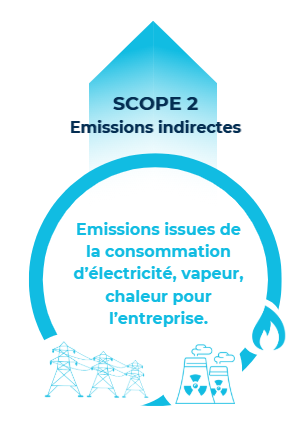Direct and indirect emissions: Mapping of SCOPES 1, 2 and 3 according to the GHG Protocol

A carbon footprint® assessment measures an organization's carbon footprint by quantifying all the direct and indirect greenhouse gas (GHG) emissions it generates. This enables a precise assessment of the organization's environmental impact. To draw up a carbon balance sheet in accordance with the applicable regulations, it is necessary to use the scopes.
Le Bilan Carbone® (voir la définition) cumule les émissions GES précises des trois scopes recouvrant trois natures d’émissions :
Scope 1: Direct GHG emissions from fixed or mobile installations controlled by the company.
Scope 2: Indirect emissions associated with the production of electricity, heat or steam imported for the organization's activities.
Scope 3: Indirect emissions, particularly from purchasing. It often represents more than 60% of a company's GHG emissions!
This is also known as scope 4 avoided emissions.
What are scopes?
Scopes are a classification system used to assess greenhouse gas (GHG) emissions as part of a Carbon Footprint®. Framed by the GHG Protocol, scopes are key tools for assessing and categorizing an organization's GHG emissions. There are 3 different types of scopes.

The 3 scopes
🏭 Le Scope 1
Scope 1 covers all emissions generated directly by the company and its activities: plants, facilities, warehouses, offices, company-owned vehicle fleets.

💡 Le Scope 2
Scope 2 covers all emissions associated with the consumption of electricity, heat or steam by the company's facilities or vehicle fleets. These are known as indirect energy emissions (GHG emissions are then generated by the producer and distributor of the electricity, heat or steam).
Scopes 1 and 2 emissions are often already the subject of monitoring and reduction targets, as they are directly the responsibility of the company, and are easy to monitor as they can be directly measured with the various energy consumption items.
Company performance is often highly optimized, so gains on scopes 1 and 2 are increasingly difficult to achieve.

🛒 Le Scope 3
Scope 3 corresponds to all other indirect emissions occurring upstream or downstream in the company's value chain.
Even if they are not directly generated by the organization, it's easy to understand that they are no less necessary to its activity.
They are often poorly optimized and therefore offer a reduction potential that is often easy to obtain, hence the importance of analyzing and measuring them precisely as part of a regulatory GHG inventory. Measuring them is not always easy, and the priority seems to be to concentrate on the major items, i.e. emissions from major Tier 1 suppliers, and those associated with upstream and downstream transport.

It should also be noted that scope 3 is a very important item, generally much higher than scopes 1 and 2.
Generally speaking, the most significant Scope 3 headings for manufacturing companies are the following:
✅ Emissions from its direct suppliers, and throughout the value chain of its products
✅ Emissions linked to upstream transport, and those linked to downstream transport and distribution
✅ Finally, in certain sectors (such as the automotive industry), emissions linked to the use of the product throughout its life cycle can be very significant. However, this item is of a different nature to the others, as it goes without saying that, in general, a product's energy efficiency is directly linked to its quality and design.
What are the main regulations, standards and methodologies for GHG assessments?
Scope 4, avoided emissions
According to the GHG Protocol, Scope 4 encompasses emissions reduced through the use of a product that replaces other goods or services, while offering similar functions but with a reduced carbon footprint. The GHG Protocol also takes into account the reduced emissions associated with recycling a product.
As you can see, understanding and applying the three scopes(Scope 1, 2 and 3) is essential for a complete and accurate assessment of an organization's greenhouse gas emissions.
These scopes provide a framework for taking into account the various sources of direct and indirect emissions, and thus identifying levers for action to reduce thecarbon footprint. By adopting a holistic approach and integrating all the scopes, organizations can better understand their impact on climate change and develop sustainable strategies to minimize their emissions.
This includes not only the reduction of direct emissions linked to their internal activities, but also the management of indirect emissions throughout their value chain.
The implementation of emission reduction measures in each scope thus makes a major contribution to the transition to an increasingly low-carbon economy.
Our carbon experts will be happy to give you a free free demonstration of our platform. 🚀







